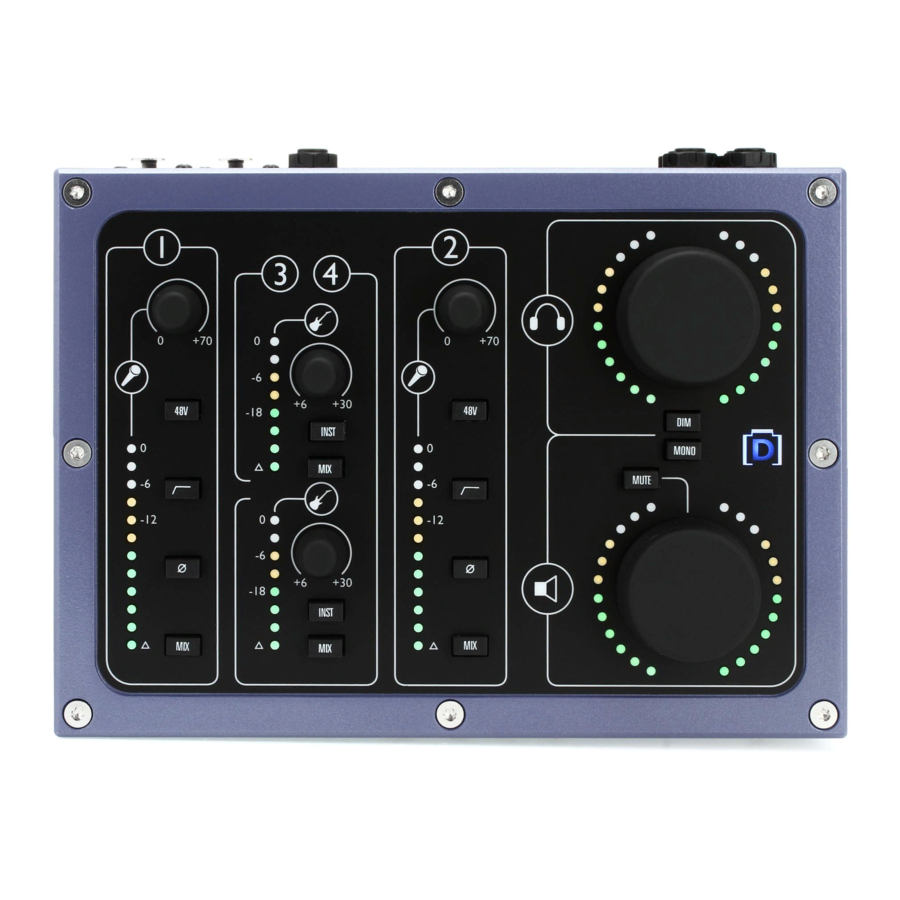
Table of Contents
Advertisement
Quick Links
Advertisement
Table of Contents

Summary of Contents for Waves DigiGrid D
- Page 1 DiGiGrid D User Guide...
-
Page 2: Table Of Contents
Manual Device Configuration ............................9 Automatic Device Configuration ........................... 9 Device Firmware ................................ 10 Identify a Device on the SoundGrid Network ......................10 DIGIGRID D CONTROL PANEL ............................11 Clock Page ..................................12 System Info Page and About Page ..........................13 Presets ................................... 13 USING AN I/O DEVICE WITH A DAW .......................... -
Page 3: Introduction
Introduction DiGiGrid D Desktop Interface is a SoundGrid I/O for studio and location applications. It has four inputs and six outputs. Two outputs are fixed level and two have level controls for precision monitoring using the headphone outputs or loudspeakers. Top-quality converters and mic preamps provide audio capture of the highest order, and the device can be networked with other SoundGrid devices. -
Page 4: Hardware And Connections
Dim and Mono: control headphones and Outputs 1 and 2 Guitar Inputs (monitor outputs). Dim: -20 dB Mic/Line Inputs, 0 to +70 dB Mute: affects monitor outputs only Monitor Output Level: controls levels of Outputs 1 and 2 DiGiGrid D / User Guide... -
Page 5: Getting Started
Connect the Hardware One I/O In this example, one DiGiGrid D is used to connect a console to the SoundGrid host application’s SoundGrid ASIO/Core Audio driver for plugin processing and/or DAW playback/recording. The interface is connected directly to the host using a Cat 5e Ethernet cable or better. -
Page 6: Add I/Os
FOH, or live room and control room. When you have more than one device in the SoundGrid network, network configuration with a 1GB Ethernet switch Only use switches tested and approved by Waves. SoundGrid host computer I/O devices 1GB Ethernet switch... -
Page 7: Download And Install Software
OUND YSTEM If you are already using a Waves SoundGrid host application and your device does not appear in the Network Devices list, use Waves Central to update the host application, which also updates the device drivers—or install just the missing device driver from Waves Central. -
Page 8: Configure The System
Please consult the user guide of your host application for specific instructions. SoundGrid QRec SoundGrid Studio Setup Window All SoundGrid devices are configured in a similar manner. Throughout this section, we show DiGiGrid IOS as an example. DiGiGrid D / User Guide... -
Page 9: Manual Device Configuration
If later you add, remove, or swap a device, Auto-Config will reconfigure your inventory and re-patch. Note that SoundGrid Studio assigns the SoundGrid driver automatically. SuperRack SoundGrid and eMotion LV1 require that the SoundGrid ASIO/Core Audio driver is assigned manually. DiGiGrid D / User Guide... -
Page 10: Device Firmware
Click on the ID button to activate a hard-to-miss LED on the panel of the corresponding hardware device. You can also activate the LED from the top bar of the device’s control panel. SoundGrid Studio SoundGrid QRec DiGiGrid D / User Guide... -
Page 11: Digigrid D Control Panel
RIVER ONTROL ANEL Open the driver control panel and then click the Hardware Control Panel button. The driver control panel is located here in the host computer: PC: C:\Program Files (x86)\Waves\SoundGrid\Driver Control Panel Mac: System HD/Applications/Waves/SoundGrid ONTROL ANEL AGES The About and System Info pages provide information about the unit, such as MAC address, SoE master MAC Address, firmware version, and more. -
Page 12: Clock Page
Internal. Range: 44.1 / 48 / 88.2 / 96 kHz. CLOCK STATUS INDICATORS Three windows on the Clock control panel help you to quickly assess the network status of the DiGiGrid D. Status Reports the presence or absence of sync between the D and the SoundGrid network Current Clock Status Displays the current sync method. -
Page 13: System Info Page And About Page
The About page is a description of the device. The System Info page contains technical details about the device, including MAC address, Firmware version, and Module version. This information is useful for troubleshooting. Please have this information handy if you contact Waves technical support concerning the device. Presets A bar at the top of the control panel lets you save and load presets. -
Page 14: Using An I/O Device With A Daw
ONFIGURE THE OUND 1. Set the DAW playback engine to “Waves SoundGrid.” The SoundGrid driver channels will now appear in the DAW I/O preferences and in the Input/Output selector in each DAW channel. 2. Route the DAW inputs and outputs to SoundGrid. -
Page 15: Specifications
Frequency Response: -3 dB <10 Hz to 100 kHz (Analog to Analog) Harmonic Distortion: 0.005% OISE Min Gain -82 dBu Max Gain -73 dBu ONITOR UTPUTS Maximum Output Level: +22 dBu Residual Output Noise: <92 dbu Output Impedance: 50 ohm Harmonic Distortion: 0.005% DiGiGrid D / User Guide... - Page 16 Signal Ground Sleeve IMENSIONS Width: 22.05 cm / 8.68 inches Height: 7.85 cm / 3.09 inches Depth: 16 cm / 6.29 inches Device Weight: 1.7 kg / 3.75 lbs Package Weight: 2.72 kg / 6 lbs DiGiGrid D / User Guide...
-
Page 17: Resetting The Unit
If after an unsuccessful firmware update the DiGiGrid D is not recognized by the SoundGrid Host Application (the DiGiGrid D device does not appear in the Inventory panel), use the Reset button (located on the DiGiGrid D back panel), to try and recover the unit.















Need help?
Do you have a question about the DigiGrid D and is the answer not in the manual?
Questions and answers